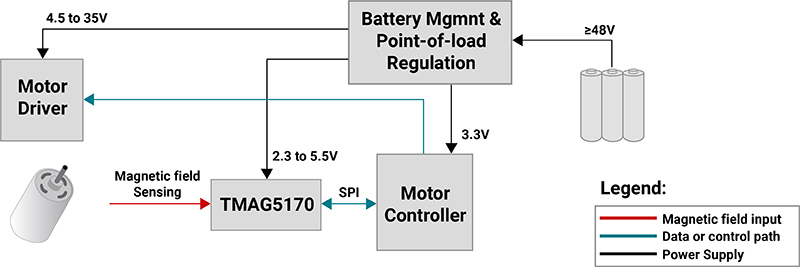As Industry 4.0 spreads advanced manufacturing processes across global markets, demand for highly automated systems that operate with an integrated manufacturing flow and constantly collect process control data is increasing drastically. Most of these systems – including magnetic encoders in robotic arms, proximity sensors, actuators, pressure transmitters, linear motors and autonomous mobile robots – require advanced position-sensing solutions to control performance and collect factory-level data for better decision-making and safer, more reliable operation of equipment.
Autonomous mobile robots like those shown in Figure 1 automate menial tasks, such as transporting materials throughout a warehouse. These industrial robots help optimize manufacturing flows, increase throughput and improve productivity. To safely and efficiently navigate a factory or warehouse floor, an autonomous mobile robot must incorporate high-precision system controls such as position sensing and speed control within the wheels.

Figure 1: Autonomous mobile robots traversing a warehouse floor
The requirement for position sensing is nearly ubiquitous among high-performance automated systems that control motion, and the choice of position-sensing technology directly affects the cost and performance of the overall system. Considerations when evaluating the best position-sensing solution include sensor accuracy, speed, power, flexibility and reliability.
Multi-axis, linear Hall-effect position sensors are usually a good option for precision automated industrial applications, because they can provide highly accurate, fast and reliable absolute position measurements. Such capabilities enable more accurate real-time control, which plays a critical role in improving equipment performance, optimizing system efficiency and minimizing downtime.
Revisiting my autonomous mobile robot example, the block diagram in Figure 2 illustrates a feedback loop between the wheels’ motor and the motor controller, using TI’s TMAG5170 linear 3D Hall-effect position sensor to monitor the exact angular position of the motor’s shaft and motor driver to spin the motor. Out of all the elements in the feedback loop, the linear 3D Hall-effect sensor will often have the most direct impact on system bandwidth and latency. By employing a sensor capable of high-bandwidth measurements, you can increase the overall speed of this feedback loop and enhance system performance.

Improve system performance with linear 3D Hall-effect position sensors
 |
Read our white paper to learn more about applications that can benefit from linear 3D Hall-effect sensors and the TMAG5170’s differentiated features. |

Likewise, a position sensor’s measurement accuracy determines to what degree it is possible to control the motion of the motor. Sensor speed and accuracy often come at one another’s expense, however, limiting system performance. The TMAG5170 eliminates this compromise by enabling high throughput readings with sensing speeds as high as 20 kSPS, and highly accurate linear measurements with a maximum total error of 2.6%.

Figure 2: Block diagram of an autonomous mobile robot wheel motor module using the TMAG5170 linear 3D Hall-effect position sensor
Depending on a design’s battery management system or power supply, power consumption may also be an important specification to consider when selecting a position sensor. Battery-powered systems or systems with a low-power supply (such as a remote 4- to 20-mA loop) typically require sensors with low-power operating modes such as wake-up and sleep and deep-sleep modes to help optimize power consumption vs. throughput. The TMAG5170’s multiple operating modes and sampling rates can increase power efficiency by at least 70% over other precision linear 3D Hall-effect sensors, enabling optimized power consumption across a 1- to 20-kHz sampling range for battery-powered devices or light-duty modes where system efficiency is a priority.
Position sensors often have stringent mechanical configuration constraints. Choosing a versatile linear 3D Hall-effect sensor with selectable magnetic sensitivity ranges and temperature compensation options can provide flexibility in magnetic and mechanical designs. The TMAG5170 has an on-chip angle-calculation engine that eliminates the need for off-chip processing while providing mechanical placement flexibility for the sensor and magnet in angle-sensing applications, including on- and off-axis configurations.
Since industrial systems increasingly work alongside humans in automated operation, additional safety measures are being progressively required to ensure safe operation, as well as increased diagnostics to prevent tool downtime and quality issues. It’s just as important to consider the reliability of a position sensor’s readings as it is to consider its accuracy, speed, power and flexibility. For instance, selecting a sensor with few or no diagnostic features may require the implementation of numerous external components in order to ensure the accuracy and reliability of sensor data, increasing a design’s bill of materials (BOM). TMAG5170 incorporates a unique combination of smart diagnostic capabilities such as communication, continuity and internal signal-path checks, as well as configurable diagnostics for the power supply, input magnetic field and system temperature. No additional components are required to ensure that the sensor data is accurate, enabling long-term reliability and a reduced BOM.
High-speed, high-accuracy position sensors are enabling the next generation of real-time control in automated industrial systems. Precision linear 3D Hall-effect sensors such as the TMAG5170 are helping designers achieve the fast, accurate and reliable measurements needed to drive Industry 4.0 market trends without sacrificing performance or increasing power consumption and cost.
Additional resources






